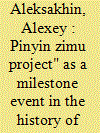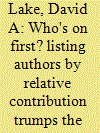| Srl | Item |
| 1 |
ID:
183453


|
|
|
|
|
| Summary/Abstract |
The creation of an alphabet and system of spelling for the Chinese language [Standard Beijing (Northern) Mandarin/Putong -hua] (the Pinyin Zimu Project) gave new life to ancient Chinese characters. In 1958, the "Great Mute," the Chinese character, began speaking to the world for the first time with the sounds of Beijing speech. Today the two forms of Chinese Mandarin writing, traditional ideographic and innovative phonographic, together ensure the linguo-cultural unity of Chinese society and the progress of science and technology in China. Millions of people in China and beyond are studying the Chinese language based on the phonetic standard of words in Putonghua. The use of letters to spell Chinese words ensures tele- and Internet communication for hundreds of millions of Chinese. In the 20th century, the first Latinized alphabet for the Chinese language was created under the influence of the experience of creating alphabets for nonliterate peoples of the USSR in 1921-1926. One of the founders and leaders of the CPC, Qu Qiubai (officially listed in the 100 Greatest Figures of New China), played a leading role in this project.
|
|
|
|
|
|
|
|
|
|
|
|
|
|
|
|
| 2 |
ID:
174492


|
|
|
|
|
| Summary/Abstract |
This paper explores the history of the alphabet revolutions in the Ottoman Empire and the Russian Empire, beginning in the 1860s and culminating with the new Turkish alphabet and the Soviet latinization movement in the 1920s. Unlike earlier works that have treated these movements separately, this article traces the origins of the alphabet revolutions to the 19th-century communications revolution, when the telegraph and movable metal type challenged the existing modes of knowledge production and imposed new epistemologies of writing on the Muslims in the Russo-Ottoman space. This article examines the media technologies of the era and the cross-imperial debates surrounding various alphabet proposals that predated latinization and suggests that the history of language reform in the Russo-Ottoman world be reevaluated as a product of a modernizing information age that eventually changed the entire linguistic landscape of Eurasia.
|
|
|
|
|
|
|
|
|
|
|
|
|
|
|
|
| 3 |
ID:
096199


|
|
|
|
|
| Publication |
2010.
|
| Summary/Abstract |
Political science as a discipline lacks any convention on the order in which authors should be listed in co-authored publications. As a result, the order of authors' surnames currently provides no information to other scholars, hiring and promotion committees, and other reviewers about the relative contributions of each collaborator. This lack of information impedes the allocation of proper credit for scholarly contributions. Moreover, in collaborations between junior and senior colleagues, or other asymmetric status hierarchies, the absence of both information and any convention tends to favor more established scholars; this makes it more difficult for graduate students, untenured professors, and other vulnerable co-authors to negotiate for and receive appropriate credit. Listing authors by relative contribution is both more informative and fair. In publications where one author provides the necessary research funding, or a faculty member is not only a co-author but also a dissertation or other academic advisor, it is also appropriate to designate that collaborator as "last" or "senior author." In all cases, articles should carry a short statement indicating the division of labor between the co-authors, even or especially if the contributions are equal.
|
|
|
|
|
|
|
|
|
|
|
|
|
|
|
|